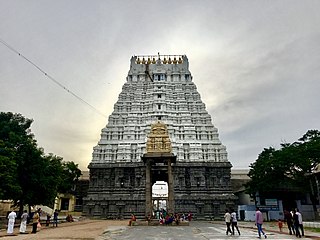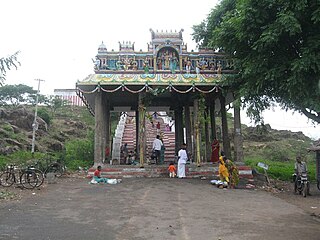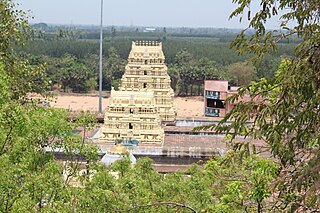
Ramanuja, also known as Ramanujacharya, was an Indian Hindu philosopher, guru and a social reformer. He is noted to be one of the most important exponents of the Sri Vaishnavism tradition within Hinduism. His philosophical foundations for devotionalism were influential to the Bhakti movement.
Athirajendra reigned for a very short period of few months as the Chola king succeeding his father Virarajendra. His reign was marked by civil unrest, possibly religious in nature. Athirajendra was last clan of Chola dynasty. He was killed in the religious chaos. Athirajindra and Virarajendra interfered in the Vengi succession disputes after the Vengi king Rajaraja Narendra, who was closely related to the Chola clan through his mother Kundavai, a daughter of Rajaraja Chola, died in 1061 CE. The Vengi throne went to Saktivarman II in a palace coup. The Cholas wanted the Chola influence re-established in Vengi. Saktivarman II was killed, but Vijayaditya, Saktivarman's father assumed the throne and repulsed the Chola attempts at unseating him. Vijayaditya however accepted to serving as a Chola vassal.

Kulothunga II was a Chola Emperor from 1133 CE to 1150 CE. He succeeded Vikrama Chola to the throne in 1135 CE. Vikrama Chola made Kulothunga his heir apparent and coregent in 1133 CE, so the inscriptions of Kulothunga II count his reign from 1133 CE. According to historians Nilakanta Sastri and T.N Subramanian, Kulottunga Chola II was not the son of Vikrama Chola and they have suggested that there was a break in the line of succession.

Alagiya Manavalan, best known by his epithet Manavala Mamunigallit. 'The great saint, Manavalan' (1370–1450), was a Hindu theologian. He was a major proponent of the Sri Vaishnavism tradition in the 15th century in Tamilakam, disseminating it with the help of his eight disciples. The disciples of Manavalan established places of learning to teach the Vishishtadvaita philosophy in Tamilakam.

Varadharaja Perumal Temple, also called Hastagiri and Attiyuran, is a Hindu temple dedicated to Vishnu located in the city of Kanchipuram, Tamil Nadu, India. It is one of the Divya Desams, the 108 temples of Vishnu believed to have been visited by the 12 poet saints, or the Alvars. It is located in a suburb of Kanchipuram known as the Vishnu Kanchi that is a home for many famous Vishnu temples. One of the greatest Hindu scholars of Vaishnava Vishishtadvaita philosophy, Ramanuja, is believed to have resided in this temple.

Kundrathur is a town located in the Chennai Metropolitan Area and the headquarters of Kundrathur taluk in Kanchipuram District. It is the birthplace of Sekkizhar, a well-known poet-saint who authored the Periyapuranam.

Thillai Nataraja Temple, also referred as the Chidambaram Nataraja Temple, is a Hindu temple dedicated to Nataraja, the form of Shiva as the lord of dance. This temple is located in Chidambaram, Tamil Nadu, India. This temple has ancient roots and a Shiva shrine existed at the site when the town was known as Thillai. Chidambaram, the name of the city literally means "stage of consciousness". The temple architecture symbolizes the connection between the arts and spirituality, creative activity and the divine. The temple wall carvings display all the 108 karanas from the Natya Shastra by Bharata Muni, and these postures form a foundation of Bharatanatyam, an Indian classical dance.
Kanchipurna was a twelfth century Vaishnavite acharya and one of the early teachers of Ramanuja. He is also known as Thirukachchi Nambigal.

The Ashtabujakaram or Ashtabuja Perumal Temple located in Kanchipuram in the South Indian state of Tamil Nadu, is dedicated to the Hindu god Vishnu. Constructed in the Dravidian style of architecture, the temple is glorified in the Nalayira Divya Prabandham, the early medieval Tamil canon of the Alvar saints from the 6th–9th centuries CE. It is one of the 108 Divya Desams dedicated to Vishnu, who is worshipped as Ashta Bhuja Perumal and his consort Lakshmi as Alamelumangai.

The Pundarikakshan Perumal Temple or Thiruvellarai Temple in Thiruvellarai, a village in the outskirts of Tiruchirappalli in the South Indian state of Tamil Nadu, is dedicated to the Hindu god Vishnu. Constructed in the Dravidian style of architecture, the temple is glorified in the Naalayira Divya Prabandham, the early medieval Tamil canon of the Alvar saints from the 6th–9th centuries CE. It is one of the 108 Divya Desams dedicated to Vishnu, who is worshipped as Pundarikakshan and his consort Lakshmi as Pankajavalli.

Tiruvekkaa Temple or Yathothkari Perumal Temple is a Hindu temple located in Kanchipuram in the South Indian state of Tamil Nadu and dedicated to the Hindu god Vishnu. Constructed in the Dravidian style of architecture, the temple is glorified in the Naalayira Divya Prabandham, the early medieval Tamil canon of the Alvar saints from the 6th–9th centuries CE. It is one of the 108 Divya Desams dedicated to Vishnu, who is worshipped as Yathothkari Perumal, and his consort Lakshmi as Komalavalli.

Eri-Katha Raamar Temple is a Hindu temple dedicated to Rama located in the town of Maduranthakam, Tamil Nadu, India. The temple is glorified by Ramanujar, Thirumalisai Alvar and classified as one of the 108 Abhimana Kshethrams of the Vaishnavate tradition. This is the sthalam (place) where Udayavar was named Ramanuja. The temple is also known by other names such as - Mathuranthaka Chaturvedi Mangalam, Vaikunda Varthanam, Thirumathurai, Thirumanthira Tirupathi, Karunagara Vilagam. Thirumalisai Alvar attained siddhi (enlightenment) in this sthalam (place). Also, Sri Ramanujar was instructed the Pancha Samskara Mantram at this place.

Devanatha Hemabhujavalli Temple is a Hindu temple in Thiruvanthipuram, a village in the outskirts of Cuddalore in the South Indian state of Tamil Nadu, dedicated to the god Vishnu and goddess Lakshmi. Constructed in the Dravidian style of architecture, the temple is glorified in the Nalayira Divya Prabandham, the early medieval Tamil canon of the Alvar saints from the 6th–9th centuries CE. It is one of the 108 Divya Desams dedicated to Vishnu, who is worshipped as Devanatha and Lakshmi as Hemabhujavalli. Though the presiding deity is Devanatha and Hemabhujavalli, the temple is known for Hayagriva, the ninth avatara of Vishnu in the Dashavatara of Vishnu and a god of knowledge. The temple is the only historical temple in South India to have a shrine of Hayagriva on hilltop.

Lakshmi Kumara Tatacharya, (1571–1643) was a prominent saint and guru of the Sri Vaishnava tradition of Hinduism. He served as the rajaguru for a ruler of the Vijayanagara Empire, Venkatapati Raya. He was also the overseer of a number of sacred temples known as the Divya Desams, including Srirangam, Kanchipuram, Tirumala, Melkote, and Srivilliputtur.

Pandavatutar Perumal Temple or Thirupadagam located in Kanchipuram in the South Indian state of Tamil Nadu, is dedicated to the Hindu god Krishna, an avatar of the god Vishnu. Constructed in the Dravidian style of architecture, the temple is extolled in the Nalayira Divya Prabandham, the early medieval Tamil canon of the Alvar saints from the 6th–9th centuries CE. It is one of the 108 Divya Desams dedicated to Vishnu, who is worshipped as Pandava Tutar Perumal (Krishna) and his consort Lakshmi (Rukmini.)

Ulagalantha Perumal Temple or Trivikrama Temple is a Hindu temple dedicated to Vishnu located in Tirukkoyilur, Tamil Nadu, India. Constructed in the Dravidian style of architecture, the temple is glorified in the Naalayira Divya Prabandham, the early medieval Tamil canon of the Alvar saints from the 6th–9th centuries CE. It is one of the 108 Divya Desams dedicated to Vishnu, who is worshipped as Ulagalantha Perumal and his consort Lakshmi as Poongothai. The temple is believed to have been built by the Medieval Cholas, with later contributions from Vijayanagara kings and Madurai Nayaks. The temple covers an area of 5 acres (20,000 m2) and has a temple tower that is the third tallest in Tamil Nadu, measuring 192 ft (59 m) in height.
Hinduism in Tamil Nadu finds its earliest literary mention in the Sangam literature dated to the 5th century BCE. The total number of Tamil Hindus as per 2011 Indian census is 63,188,168 which forms 87.58% of the total population of Tamil Nadu. Hinduism is the largest religion in Tamil Nadu.

The Govindaraja Perumal Temple, also called Thiruchitrakoodam, is a temple dedicated to the Hindu god Vishnu, situated in Chidambaram, a town in the South Indian state of Tamil Nadu. The temple is inside the premises of the Thillai Nataraja Temple, constructed in the Dravidian architecture. The temple is glorified in the Naalayira Divya Prabandham, the early medieval Tamil canon of the Alvar saints from the 6th–9th centuries CE. It is one of the 108 Divya Desam dedicated to Vishnu, who is worshipped as Govindaraja Perumal and his consort Lakshmi as Pundarikavalli Thayar.

Nilathingal Thundam Perumal temple is a Hindu temple dedicated to Vishnu, located in Kanchipuram in the state of Tamil Nadu, India. The temple is located in a shrine in Ekambareswarar Temple, the largest temple in the town of Kanchipuram, located in the northern part of the town. The temple gopuram is 59 m tall, which is one of the tallest gopurams in India.
Mahapurna, also called Periyanambi, was one of the teachers and maternal uncle of the medieval Vaishnava philosopher Ramanuja. He was responsible for initiating Ramanuja into Sri Vaishnavism.
















